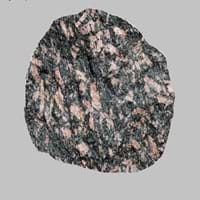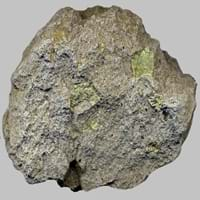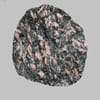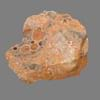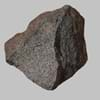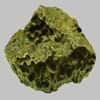Definition
Luxullianite is a rare type of granite, known for presence of clusters of radially arranged acicular tourmaline crystals which are enclosed by phenocrysts of orthoclase and quartz in a matrix of quartz, tourmaline, alkali feldspar, brown mica.
Minette is a variety of Lamprophyre and is porphyritic alkaline igneous rock which is mainly dominated by biotite and potassic feldspar
Discoverer
Unknown
Unknown
Etymology
From the village of Luxulyan in Cornwall, England, where this variety of granite is found
From French mine ore, mine + ette
Class
Igneous Rocks
Igneous Rocks
Sub-Class
Durable Rock, Hard Rock
Durable Rock, Medium Hardness Rock
Other Categories
Coarse Grained Rock, Opaque Rock
Coarse Grained Rock, Fine Grained Rock, Opaque Rock
Texture
Granular, Phaneritic
Porphyritic
Color
Black, Grey, Orange, Pink, White
Black, Bluish - Grey, Brown, Dark Greenish - Grey, Green, Grey
Durability
Durable
Durable
Scratch Resistant
Yes
Yes
Appearance
Veined or Pebbled
Dull, Banded and Foilated
Interior Uses
Bathrooms, Countertops, Decorative Aggregates, Entryways, Floor Tiles, Homes, Hotels, Interior Decoration, Kitchens, Stair Treads
Countertops, Decorative Aggregates, Interior Decoration
Exterior Uses
As Building Stone, As Facing Stone, Paving Stone, Garden Decoration, Office Buildings
As Building Stone, As Facing Stone, Garden Decoration
Other Architectural Uses
Curbing
Curbing
Construction Industry
As Dimension Stone
As Dimension Stone, Cement Manufacture, for Road Aggregate, Making natural cement, Manufacture of Magnesium and Dolomite Refractories
Medical Industry
Not Yet Used
Taken as a Supplement for Calcium or Magnesium
Antiquity Uses
Artifacts, Monuments, Sculpture
Artifacts, Monuments, Sculpture, Small Figurines
Commercial Uses
Creating Artwork, Curling, Gemstone, Laboratory bench tops, Tombstones
An Oil and Gas Reservoir, As a Feed Additive for Livestock, Gemstone, Metallurgical Flux, Production of Lime, Soil Conditioner, Source of Magnesia (MgO)
Types
Igneous Protolith Granite, Sedimentary Protolith Granite, Mantle Granite, Anorogenic Granite and Hybrid Granite
Minette, Alnoite, Camptonite, Monchiquite, Fourchite, Vogesite, Appinite and Spessartite
Features
Available in Lots of Colors and Patterns, It is One of the Oldest, Strongest and Hardest Rock
Always found as volcanic pipes over deep continental crust, Host rock for Diamond, Is one of the oldest rock, Surfaces are often shiny
Archaeological Significance
Famous Monuments
Data Not Available
Data Not Available
Famous Sculptures
Data Not Available
Data Not Available
Pictographs
Not Used
Used
Petroglyphs
Not Used
Used
Formation
Luxullianite is an intrusive igneous rock which is very hard, crystalline and is visibly homogeneous in texture. It is found in large plutons on the continents, i.e. in areas where the Earth's crust has been deeply eroded.
Minette formation takes place deep beneath the Earth’s surface at around 150 to 450 kms, and are erupted rapidly and violently.
Mineral Content
Amphibole, Biotite, Feldspar, Hornblade, Micas, Muscovite or Illite, Plagioclase, Pyroxene, Quartz
Amphibole, Carbonate, Garnet, Micas, Olivine, Phlogopite, Pyroxene
Compound Content
Aluminium Oxide, CaO, Iron(III) Oxide, FeO, Potassium Oxide, MgO, MnO, Sodium Oxide, Phosphorus Pentoxide, Silicon Dioxide, Titanium Dioxide
Aluminium Oxide, NaCl, CaO, Iron(III) Oxide, FeO, Potassium Oxide, MgO, MnO, Sodium Oxide, Silicon Dioxide, Titanium Dioxide
Types of Metamorphism
Burial Metamorphism, Cataclastic Metamorphism, Contact Metamorphism, Hydrothermal Metamorphism, Impact Metamorphism
Burial Metamorphism, Cataclastic Metamorphism, Contact Metamorphism, Hydrothermal Metamorphism, Impact Metamorphism, Regional Metamorphism
Types of Weathering
Biological Weathering, Chemical Weathering, Mechanical Weathering
Biological Weathering, Chemical Weathering
Types of Erosion
Chemical Erosion, Water Erosion, Wind Erosion
Chemical Erosion, Coastal Erosion, Sea Erosion, Wind Erosion
Grain Size
Large and Coarse Grained
Fine to Coarse Grained
Fracture
Not Available
Conchoidal
Porosity
Less Porous
Very Less Porous
Luster
Dull to Grainy with Sporadic parts Pearly and Vitreous
Subvitreous to Dull
Compressive Strength
Not Available
Cleavage
Not Available
Conchoidal
Toughness
Not Available
Not Available
Specific Gravity
2.6-2.7
2.86-2.87
Transparency
Opaque
Translucent to Opaque
Density
2.6-2.8 g/cm3
2.95-2.96 g/cm3
Specific Heat Capacity
Not Available
Resistance
Heat Resistant, Wear Resistant
Heat Resistant, Impact Resistant
Deposits in Eastern Continents
Asia
China, India, Iran, Saudi Arabia, Sri Lanka, Taiwan, Thailand, Turkey, Vietnam
Russia
Africa
Angola, Egypt, Madagascar, Namibia, Nigeria, South Africa
Angola, Botswana, Cameroon, Ethiopia, South Africa
Europe
Austria, Belgium, Finland, France, Germany, Italy, Norway, Sardinia, Spain, Switzerland, The Czech Republic, Venezuela
England, Hungary, Iceland, United Kingdom
Others
Not Yet Found
Antarctica, Greenland
Deposits in Western Continents
North America
Canada, USA
Canada, Mexico, USA
South America
Not Yet Found
Argentina, Colombia, Ecuador
Deposits in Oceania Continent
Australia
Not Yet Found
New South Wales, New Zealand, Queensland, South Australia, Western Australia
Luxullianite vs Minette Characteristics
Though some rocks look identical, they have certain characteristics which distinguish them from others. Characteristics of rocks include texture, appearance, color, fracture, streak, hardness etc. Luxullianite vs Minette characteristics assist us to distinguish and recognize rocks. Also you can check about Properties of Luxullianite and Properties of Minette. Learn more about Luxullianite vs Minette in the next section. The interior uses of Luxullianite include Bathrooms, Countertops, Decorative aggregates, Entryways, Floor tiles, Homes, Hotels, Interior decoration, Kitchens and Stair treads whereas the interior uses of Minette include Countertops, Decorative aggregates and Interior decoration. Due to some exceptional properties of Luxullianite and Minette, they have various applications in construction industry. The uses of Luxullianite in construction industry include As dimension stone and that of Minette include As dimension stone, Cement manufacture, For road aggregate, Making natural cement, Manufacture of magnesium and dolomite refractories.
More about Luxullianite and Minette
Here you can know more about Luxullianite and Minette. The life cycle of a rock consists of formation of rock, composition of rock and transformation of rock. The composition of Luxullianite and Minette consists of mineral content and compound content. The mineral content of Luxullianite includes Amphibole, Biotite, Feldspar, Hornblade, Micas, Muscovite or Illite, Plagioclase, Pyroxene, Quartz and mineral content of Minette includes Amphibole, Carbonate, Garnet, Micas, Olivine, Phlogopite, Pyroxene. You can also check out the list of all . When we have to compare Luxullianite vs Minette, the texture, color and appearance plays an important role in determining the type of rock. Luxullianite is available in black, grey, orange, pink, white colors whereas, Minette is available in black, bluish - grey, brown, dark greenish - grey, green, grey colors. Appearance of Luxullianite is Veined or Pebbled and that of Minette is Dull, Banded and Foilated. Properties of rock is another aspect for Luxullianite vs Minette. The hardness of Luxullianite is 6-7 and that of Minette is 5-6. The types of Luxullianite are Igneous Protolith Granite, Sedimentary Protolith Granite, Mantle Granite, Anorogenic Granite and Hybrid Granite whereas types of Minette are Minette, Alnoite, Camptonite, Monchiquite, Fourchite, Vogesite, Appinite and Spessartite. Streak of rock is the color of powder produced when it is dragged across an unweathered surface. The streak of Luxullianite and Minette is white. The specific heat capacity of Luxullianite is 0.79 kJ/Kg K and that of Minette is Not Available. Depending on the properties like hardness, toughness, specific heat capacity, porosity etc., rocks are resistant to heat, wear, impact, etc.Luxullianite is heat resistant, wear resistant whereas Minette is heat resistant, impact resistant.
